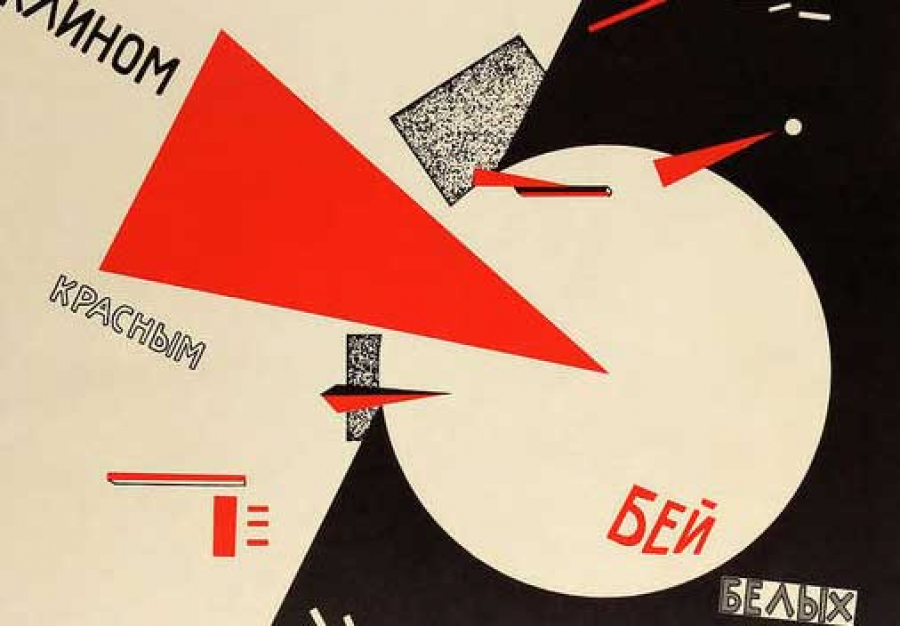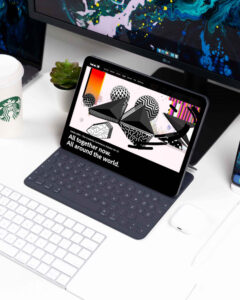How many times have you seen the popular posters in red and black or primary colors with geometric shapes? The truth is that they date back many decades since they were created by artists belonging to Russian Constructivism. It is an artistic movement, mostly pictorial and architectural, which emerged in Russia around 1914. Its splendor was after the October Revolution, known as the Bolshevik Revolution. It is probably the artistic avant-garde developed in the twentieth century that has been most closely linked to a particular country’s political currents. Constructivism represented a visual identity for Soviet communism, and its main objective was to bring art to the people, rescuing it from the elites.
*Featured image: El Lissitzky - 1919 - poster - Beat the Whites with the Red Wedge
* Alexander Rodchenko, Books poster 1924
More than just a style, Russian Constructivism is considered a philosophy, reflecting a belief in art for social change rather than personal expression. Artists opted for utilitarian and propagandistic work, where aesthetics are always at the service of function. In this way, they were conceived as “artist-engineers.” In this context, Constructivism rejected the decorative and ornamental excesses considered typical of bourgeois art. In contrast to the neoclassicism and Art Nouveau prevailing in Europe, an art based on simplicity, pure lines, and geometric forms, inspired by cubism and futurism, was created.

Artists like Anton Pevsner, Naum Gabo, or Aleksandr Rodchenko were the representatives of a movement that witnessed how the revolutionary proletarian movement replaced bourgeois culture. But the most outstanding figure is that of Vladimir Tatlin; in his conception of art, he disavowed the works confined to museums or large art centers, for Tatlin the work should participate in society. Beyond the political link, it is undeniable that these artists’ experimentation with different media and technologies has innovated in the visual field. Their legacy lies in important advances in the areas of photography, advertising, design, and publicity. It was of such importance that today we could see a large number of artists and works inspired by Russian Constructivism.
The origin of political propaganda
In October 1917, the revolutionary movement led by Vladimir Lenin overthrew the bourgeois government in power. After establishing itself in Moscow, it began to spread throughout Russia, giving rise to the Socialist Revolution, a proletarian movement. Since then, Lenin promoted a policy of socialization of the economy that proposed among its measures the nationalization of land and private industries and the revocation of the right to private property. Meanwhile, Constructivism emerged when the USSR needed a radical change of identity and had to show a new image of the country. Artists shared the revolutionary spirit and wanted to change the world with their works from a utilitarian and functional perspective by spreading the Revolution’s goals.
The USSR helped build the avant-garde that this historical experience exemplifies the beginning and end of a utopia: the relationship between the political avant-garde and the artistic avant-garde. Between the beginning of the Revolution and the 1930s, the dream of avant-garde becoming a social and political reality seduced many European architects and artists. Previously, the avant-garde had penetrated Russian culture, from the formalist investigations on language that would influence the construction of the most radical avant-gardes to the European echoes of avant-gardes through Cubo-futurism, Rayonism, or Suprematism. From Malevich to Maiakovski, the Russian avant-garde would not take long to commit itself to a utopia that, born in the bosom of artistic practices, would seek to link itself to the construction of socialism, aspiring to the formal configuration of the new revolutionary society.

In this context, associations of architects and painters emerged to discuss ideas and approaches to the reconfiguration of the way of life in this new society. This love affair between art and politics gradually grew. Lenin included artists and architects in his list of heroes of the Revolution, gaining the artistic sphere’s support. During the four years of the reorganization of Russian life from political militancy, art schools were reformed throughout the country, museums were built, and political festivals were organized with the collaboration of painters, actors, writers, and composers. The Revolution supported the avant-garde with specialized institutes and the reform of artistic and architectural education. This allowed artists and intellectuals like Maiakovski, V. Tatlin, El Lissitzky, or Malevich the opportunity to institutionalize the avant-garde.

Russian Constructivism thus became the official art of the Russian Revolution after its triumph and the aesthetic manifestation of the new socialist society. Constructivists understood art as one more tool of the Revolution, which could and should contribute to the formation of the new social order and the spread of socialist ideology. The first years of the new socialist regime were of greater exploration in the theoretical field than concrete constructions. Artistic production was limited to serving as a means of dissemination and propaganda of socialism through murals and commemorative monuments with a more architectural than sculptural imprint to represent the proletariat’s greatness and the state.
The design style was mainly influenced by the Industrial Revolution that the Soviet territory experienced after the Revolution. We see this in one of the key works of Constructivism, Vladimir Tatlin’s Monument to the Third International, which was never built, and combined a machine aesthetic with dynamic components that celebrated technology, such as spotlights and projection screens.
The foundations of graphic design
During Russia’s transformation, the sense of approaching the working class, the public in general, made more sense through the poster than with the canvas support. Russian Constructivism arrived with this new support, for that same sense of an approach to the people is ideal for conveying a message and is still used to this day. Its use laid the foundations of graphic design and other avant-garde movements such as Dadaism, giving a new way of working from the visual arts. Tatlin, the initiator of this movement, also experimented with painting and industrial materials since they are closer to the worker.
The importance of the poster was not only transferred to political propaganda. Aleksandr Rodchenko, for example, made posters for product advertising. In general terms, the design of these graphics had the purpose of creating and projecting messages through images, just like art, which is also called visual communication. The main difference with painting is that design has a very clear purpose, function, and communicative objectives. It exists to solve a problem. In other words, what differentiates one from the other is perspective and intention.

One could speak of two tendencies in constructivist design. On the one hand, one of them is simply aesthetic and defends the freedom of creation. It is represented by Kandinsky, Malevich, Gabo, and Pevsner, who spread this style in Europe between 1921 and 1922. These artists defended the subjective in the work of art and then turned to Suprematism.
The other current was led by Tatlin and Rodchenko, who put design at the Revolution’s service, turning art into just another product. In 1921, 25 artists led by the two artists mentioned above renounced “art for art’s sake” and called on artists to stop producing useless things, to dedicate themselves to industrial design, visual communication, and applied arts in the service of the new communist society. The messages to be sent had to be clear and simple, forceful, and objective to influence society.

One of the forerunners of design is El Lissitzky’s political poster, “Beat the Whites with the Red Wedge.” Aggressive-looking red triangles and lines in varying directions of attack push back the figure on the right side of the poster: a large white circle on a black surface. This composition, made with very simple typographic and graphic means, has lost none of its original expressive force today. Other pioneering works in the field of typography and poster design were those of Rodchenko, Kluzis, and Alexei Gan.
In collaboration with the workshops, the artists organized exhibitions and designed badges, posters, transparencies, stamps, and tools for the newly created workers’ clubs, mostly on a geometrical basis. Melnikov’s pavilion for the Universal Exhibition of Decorative Arts in Paris in 1925 surprised the public with its strictly geometric proportions, as did the Cubist works exhibited there. From 1923 to 1925, the constructivists’ organ was the magazine LEF, and from 1927 to 1928, NOVYI LEF. Mayakovski and Rodchenko collaborated closely together. Their designs consisted of photomontages and typographies integrated with their predominantly horizontal lines, with carefully constructed type and futuristic accentuation of the mechanical. El Lissitzky’s works, on the other hand, were based on syntheses of constructivist and Suprematist principles. Asymmetrical and dynamic diagonals determined the structure of the design.

The photomontages by Rodchenko, Lissitzky, and Kluzis testified to their political commitment and analytical thinking. Rodchenko’s leaflet designs already outlined the clean and clear arrangement in columns of typographic and photographic compositions. The photographs were inserted in the text columns, and the contrast between black and white highlighted the headlines and headings. In 1921, Lissitzky and Ilya Ehrenburg left Russia for Germany. They founded the multilingual magazine Weschtsch/Gegenstand Objekt, in which they informed readers about artistic developments in Russia and modern trends in Western Europe. Thanks to this, Lissitzky came into contact with many progressive artists and was decisive in developing visual communication in the West.
Generally speaking, Constructivism reacted against the previous century’s visual model by rejecting the long tradition of the fine arts. The artists aimed to abolish the traditional artistic preoccupation with composition and replace it with “construction.” The preference for ornamentation and variation of typefaces in the same graphic piece was replaced by the new interest in geometry and stripped-down design, such as sans serif typography. The most important innovation of this movement remains in the field of communication. Many of the artists later turned to industrial design and visual communication. Rodchenko founded an advertising agency together with the poet Mayakovski, which produced more than 150 designs and advertising pieces between 1923 and 1925. How the constructivists tried to communicate messages syntactically can be seen today in signage with two basic components in common: instantaneity and universality.











